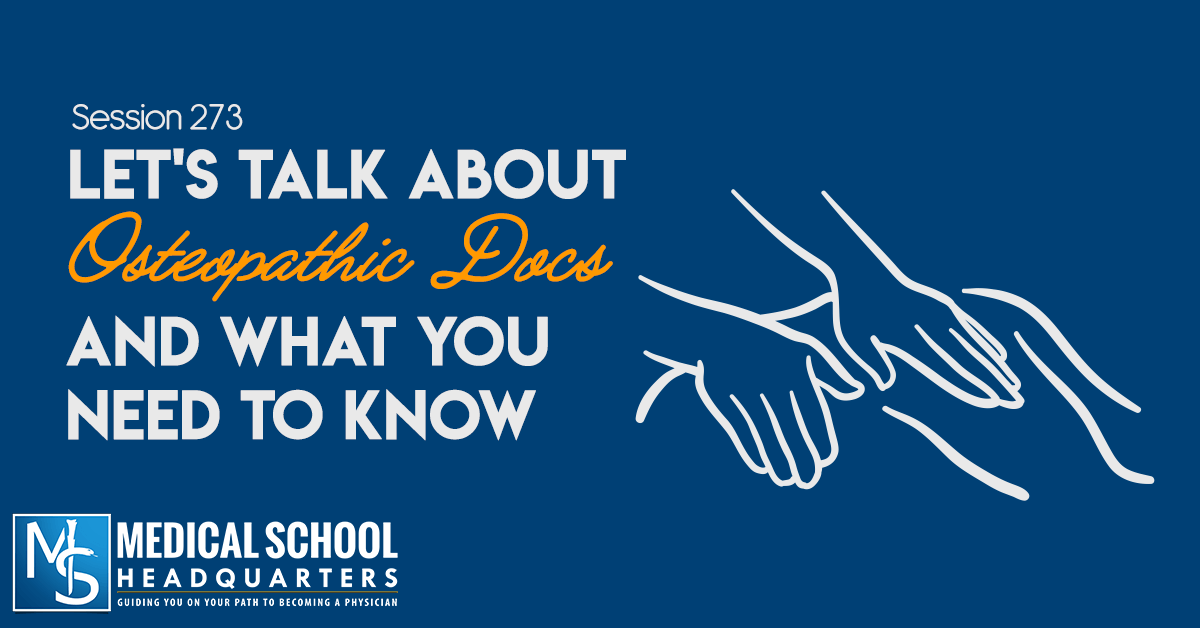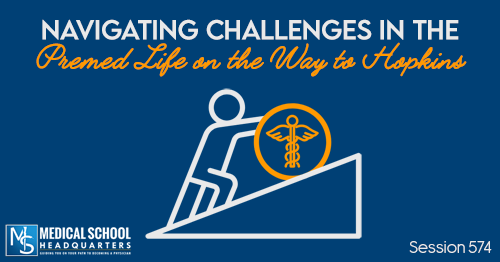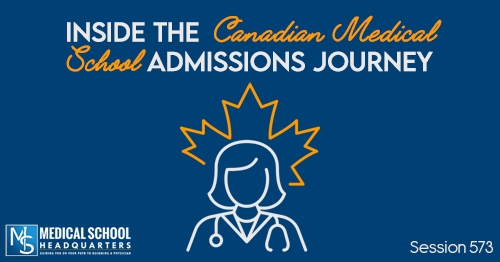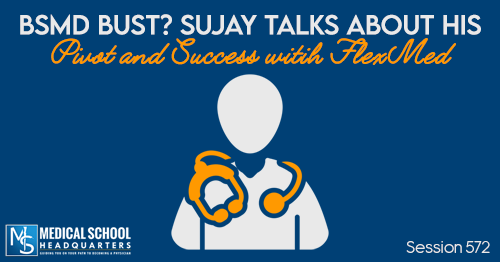Apple Podcasts | Google Podcasts

Session 273
Dr. Daniel Clearfield is a Family and Sports Medicine trained OMT doc. We talked about his journey to DO school, some struggles that DOs have and much more.
The Premed Playbook Guide to the Medical School Personal Statement is now available for preorder on Amazon, Barnes and Noble, or wherever you buy your books. If you haven’t yet, also check out The Premed Playbook Guide to the Medical School Interview.
If you’re still trying to figure out whether or not you want to apply to MD schools or DO schools or both, this is a must-listen episode. If you’re hesitant in applying to DO schools or don’t know about DO or osteopathic manipulative medicine (OMT), again, listen to this podcast.
In this episode, Daniel discusses OMT and about how he approaches OMT. Find out how he has been able to add it to his toolbox in helping his patients.
[02:25] An Interest in Kinesiology and Eventually, Medicine
Having a father as a doctor, Daniel saw how hard it was to be one. His high school guidance counsellors even encouraged him to follow the path of his dad but he didn’t initially liked the idea. For college, he did mechanical engineering for a year and a half. Realizing the kinds of peers and the things he’d be doing, he stumbled upon Kinesiology as a major. At that time, he was already working as a personal trainor since high school. So he was looking at the different paths he could use with it. Nevertheless, he didn’t see this as challenging enough. So he went on his journey and realized becoming a sports medicine physician was something he would want to do. Eventually, he started doing some externships in college and got to work with an orthopedic surgeon that specializes in Sports Medicine, as well as a primary care sports medicine doctor who later became one of his mentors. He also worked with a physiatrist, Physical Medicine & Rehabilitation Specialist.
[Tweet “”Even though going into college, it was the last thing I was thinking about, medicine ended up finding its way to me rather than me finding my way to it.” https://medicalschoolhq.net/pmy-273-lets-talk-about-osteopathic-docs-and-what-you-need-to-know/”]
It wasn’t his dad being a negative influence that held him back from being a doctor. His dad never really brought work home, but he was tired and would get called in the middle of night. So he just saw the negative effects in terms of lack of presence at times. He was a big cholesterol expert so he was flying around the world frequently. He’d be gone at times, and he felt having an absentee father. So all this drove him away from getting into medicine. It was more of seeing his lifestyle that initially turned him off.
However, when he got to do the shadowing experiences and with the primary care sports medicine physician, he found it very cool. They were treating not just athletes but people of all ages who had various ailments. Osteopathic manipulation was a part of it and he got fascinated by all the stuff that involved kinesiology.
[Tweet “”Here is a practice where we are directly taking everything that we’re learning in college in this Kinesiology degree and we’re directly applying that into medicine, into practical use.” https://medicalschoolhq.net/pmy-273-lets-talk-about-osteopathic-docs-and-what-you-need-to-know/”]
In fact, none of Daniel’s friends back in college who also got a Kinesiology degree was using any Kinesiology degree to the extent that he is using it now. That said, he loved his major.
Moreover, Daniel pointed out one characteristic he had that other personal trainors had, which was having that humility to say he doesn’t know. And this bothered him a lot. He had more questions. He wanted to dig into more info and this is what got him started to look into medicine.
[08:35] Allopathic versus Osteopathic
Daniel explains that typically, allopathic physicians would look at xrays and MRI’s and tell the patient the diagnosis and just present them with options as far as surgery or therapy. So he didn’t really see having too many options.
Not meaning to generalize, but a lot of times, the MD physicians would excuse themselves and he’d find himself being left behind with the patients in the room. And they would still have a lot of questions. That made him feel very powerless and helpless to do anything. And having worked with DOs he has worked with, he saw that DO model of partnering with the patients.
[Tweet “”I saw more of that behavior model of partnering with the patients, sitting down, touching the patient just so they know that they’re actually being listened to.” https://medicalschoolhq.net/pmy-273-lets-talk-about-osteopathic-docs-and-what-you-need-to-know/”]
He felt that time spent with the patients understanding them and answering questions was just better quality time regardless whether OMT was employed or not. In short, he saw better patient interaction he was seeing with the osteopathic physicians.
Moreover, his father has also helped him identify those individuals who are respected in the profession. While he found the allopathic individuals he worked with on his own.
Daniel applied through the TMDSAS (Texas Medical and Dental Schools Application Service). He applied to one osteopathic school (which was the only one at that time) and then he applied to another school.
[10:55] What Is OMT?
Daniel explains that it’s common misconception to compare osteopathic manipulative treatment (OMT) to chiropractic treatment. But they want to keep it separate. The founder of chiropractic manipulation, D.D. Palmer, was the pupil of Andrew Taylor Still, who was the founder of osteopathic medicine. Still was an MD who was a surgeon during the civil war times. There were just a lot of bad treatments where he suffered the loss of several of his family members. And he look at medicine thinking there’s gotta be a better way they could be doing things. Hence, he came up with the manipulation. It was mainly a philosophical difference between what was being practiced at that time.
Meanwhile, Palmer took his own direction and does a lot of thrusting type techniques. There was not much work on the myofascia. But from Still’s teachings came the osteopathic professions which still works in parallel with the allopathic profession in regards to the type of things you’re being trained with. Additionally, you’re being taught a different philosophical approach and more of a holistic type of approach in terms of patient interaction. You’re also taught osteopathic manipulation and how that could be a part of being able to help your patients.
[Tweet “”It’s not an absolute as far as all DOs have to use osteopathic manipulation. But all DOs have been exposed to osteopathic manipulation.” https://medicalschoolhq.net/pmy-273-lets-talk-about-osteopathic-docs-and-what-you-need-to-know/”]
This being said, in addition to the routine medical classes allopathic medical students are exposed to, osteopathic students would be doing classes in osteopathic manipulation. They would have to take didactic classes as well as some lab courses 1-2 times a week where they get to practice their hands-on skills.
[Tweet “”One of the first things that we learned is how to touch a patient, how to actually create that somatic connection where we’re actually putting our hands on somebody.” https://medicalschoolhq.net/pmy-273-lets-talk-about-osteopathic-docs-and-what-you-need-to-know/”]
Once they had their clinical rotations, many of them just got more comfortable in terms of patient interaction. They were finding their flow in the hospital setting much quicker than some of their allopathic colleagues due to their hands-on experience.
[14:50] Should You Apply to DO Schools?
Daniel explains this is not for everybody. For instance, going through the TMDSAS, they had several students who ranked allopathic medical schools and trickled into osteopathic medicine. And when he started teaching for six years at the medical school he went to Fellowship to, they saw those people who weren’t motivated enough to get involved with it.
When looking to going to an osteopathic school, there are several people who want nothing to do with OMT, but they still embrace the osteopathic philosophy. Daniel says this is okay.
For example, if you know that you want to be a dermatologist and the use of OMT and dermatology is their use, for the most part, you’re not typically doing OM in a dermatology type practice. But if you embrace the principles and practice of what osteopathic manipulation is about and you want to pay attention to those aspects, if you want to understand how the bodies are more interconnected and how that affect disease processes, then that’s were DO schools can offer great advantage to you.
Additionally, Daniel mentions there are several individuals out there that are Osteopathic Manipulative Medicine Specialists and this is the only thing they do in their practice is osteopathic manipulation.
[Tweet “”There are several individuals out there that are Osteopathic Manipulative Medicine Specialists and this is the only thing they do in their practice is osteopathic manipulation.” https://medicalschoolhq.net/pmy-273-lets-talk-about-osteopathic-docs-and-what-you-need-to-know/”]
[16:30] His Decision to Teach
Many of these physicians are brilliant with their hands. But at the same time, when they speak about what they’re doing, Daniel would describe it as like “diarrhea” coming out of their mouth. He considers them to be silent mentors since vocally, they could make you down where they speak out of concepts that are not evidence-based.
When Daniel went through his manipulative medicine courses, he saw the value of learning how to do it while also seeing the frustration of many of his classmates. They got quickly disenchanted with the profession as a whole because they didn’t see the point of learning OMT to become a doctor. And they just wanted to go to medical school and be a doctor. This said, they never got the whole picture and they became those disenchanted physicians that totally turned away from the osteopathic profession. That if they had the option, they would quickly convert to an MD profession.
Daniel saw this so he decided to really learn his stuff and he did an extra fellowship so he would have further understanding of it.
[Tweet “”I wanted to go back and make sure that people aren’t getting so frustrated with the profession, that they see that there is value as to what we’re learning here and how they can apply it to any field that they have.” https://medicalschoolhq.net/pmy-273-lets-talk-about-osteopathic-docs-and-what-you-need-to-know/”]
[19:28] Limitations versus Indications
Daniel explains that OMT is an elective treatment. There’s no stat for an OMT but it’s an optional thing you can do to better help the patient. There are several ways you can use it and there are also several ways they can’t. For example, this can be in cases where you can see that the patient is going to be a liability. Especially in the current day where inappropriate touches are a highly controversial topic. So you don’t want to have anything that is slightly off the standard beaten path. In this scenario, Daniel would avoid any kind of OMT.
From a sports medicine standpoint, OMT is an elective procedure. So he has to apply this to someone who gets injured in the field. But if they’re a minor, he would need a parental consent for him to do it. This is another potential limitation of OMT.
Conversely, in terms of what he can do with OMT to help people, there are several situations that you can do it. He recalls an experience that he got to use OMT, which although not necessary, it was able to better help the patient. From a sports medicine standpoint, when he did residency in Ohio, he worked with an orthopedic surgeon. They would see athletes and he’d be asked to do OMT. So while the MD got out of options as to what to do, he was able to find other things that were able to help that athlete out at that time.
[25:40] The Subjectivity of OMT and the Lack of Research
Daniel that a big part of the lack of data is that subjectivity part of OMT. He participated in some OMT research protocols and when he did his Master’s degree, the first year he was working on his thesis, he was trying to do a clinical trial with it. After doing a lot of research background, he realized it was going to be very difficult for him to do a trial like that.
[Tweet “”It’s hard to have a placebo-controlled trial where you’re really evaluating the efficacy of OMT and to standardize how OMT is done.” https://medicalschoolhq.net/pmy-273-lets-talk-about-osteopathic-docs-and-what-you-need-to-know/”]
Another thing Daniel believes osteopathic schools aren’t strong with is research. Although this has gotten better. His father is a big osteopathic researcher. But he feels that a lot of his allopathic colleagues have a better background in terms of conducting research, how to do clinical trials benchwork type research, etc. This is not a strong point among osteopathic schools however although some are trying to get better at this.
Research was something that was taught but compared to some of his friends who went to allopathic school, it wasn’t taught at the same level where they would feel comfortable as conducting their own research going into practice.
Moreover, he refers to OMT as a very subjective thing in terms of feeling for different kinds of tissues and looking at different kinds of outcomes. With OMT, you’re not a technician but a physician. So there is an art of medicine in what you’re doing. That said, you may come up with different treatment plans based off of different factors related to the individual. But this is hard to standardize in a research sense.
[Tweet “”Research has its value in medicine. Evidence medicine definitely has a lot of value to it. But if you only go off of that, that’s where you’re only limiting yourself and you stay close-minded to other things.” https://medicalschoolhq.net/pmy-273-lets-talk-about-osteopathic-docs-and-what-you-need-to-know/”]
[29:18] Better Patient Care: An Additional Tool in your Toolbox
Ultimately, what medicine all boils down to is that it centers around the patient and doing what’s best for the patient. Daniel believes that by knowing things like OMT, he feels much more capable that he’s able to help patients out. He has been able to figure things out on certain patients where other doctors have failed. He has been able to offer other different treatment where other doctors have not. So he feels he has this additional tool in his toolbox that he can offer and that’s extremely helpful in patient care.
[Tweet “”I have been able to offer other different treatment where other doctors have not. I feel like I have this extra tool in my tool box at all times that’s extremely helpful in patient care.” https://medicalschoolhq.net/pmy-273-lets-talk-about-osteopathic-docs-and-what-you-need-to-know/”]
[30:00] Ways to Get Exposed to the DO World the Right Way
Daniel recommends to students looking to get exposed to the DO world is to find a good physician, be it an MD or DO doctor. Sometimes too, you can go based off recommendations of other students. Learn what type of physician you’re thinking of doing and try to find a good mentor in that. Some people are not only disenchanted with the osteopathic profession but also with medicine. So if you shadow with them, you’re not going to have any interest and influence to go into medicine at all.
Daniel adds that not everybody is a good teacher and instructor. Not everybody has that passion to pass along what is going on with them in medicine.
[Tweet “”It’s not just finding somebody you can rotate with, but finding somebody good who’s going to really answer the questions that you have.” https://medicalschoolhq.net/pmy-273-lets-talk-about-osteopathic-docs-and-what-you-need-to-know/”]
All this being said and if he had to go back all over again, Daniel would still have done this all over again since he loves what he does. He wants to make that people getting into this are truly about wanting to do this.
Ultimately, whatever specialty you want to do, if you want to be a DO, you can do it! At the end of the day, if you want to be a physician, apply to both MD and DO schools. Since you can do anything you want to do as a DO. Be open-minded. You have to go through the OMT training and learn but you don’t have to do it in practice if you don’t want to or if you don’t believe in it.
Links:
The Premed Playbook Guide to the Medical School Personal Statement











